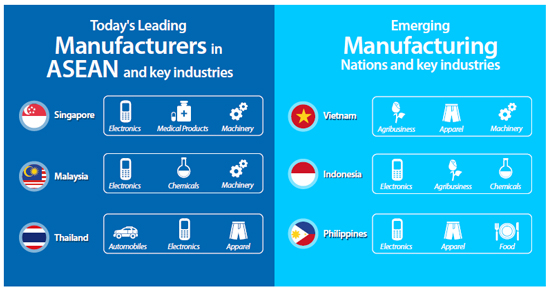Manufacturing Hubs Across Southeast Asia
By Matthew Zito and Kezia Hardingham, Dezan Shira & Associates
Manufacturing across the Association of Southeast Asian Nations (ASEAN)—the ten-nation bloc including Singapore, Malaysia, Thailand, Vietnam, and Indonesia—is by no means a monolithic sector. From free-market champions like Singapore to planned economies such as Vietnam; from hotbeds of political turbulence like Thailand to bastions of stability such as Indonesia; the region features a diverse array of economic structures, operational expenses, and states of infrastructure development.
 In a broad perspective, ASEAN manufacturers can be divided into those that have invested in mid- and high-tech manufacturing and those which, for the time being, are concentrated in low- or no-tech assembly. Not surprisingly, the former tend to feature higher minimum wages and highly skilled workforces, as exemplified by Singapore, whose manufacturing wages are well above those of its regional neighbors.
In a broad perspective, ASEAN manufacturers can be divided into those that have invested in mid- and high-tech manufacturing and those which, for the time being, are concentrated in low- or no-tech assembly. Not surprisingly, the former tend to feature higher minimum wages and highly skilled workforces, as exemplified by Singapore, whose manufacturing wages are well above those of its regional neighbors.
Conversely, the latter type of manufacturing nation describes states such as Vietnam and Indonesia, where strides are currently being made in education and infrastructure investment as a means of avoiding the specter of low-value added manufacturing. Both countries face their own respective challenges however; in Vietnam, this consists of mitigating the influence of state-owned enterprises on the economy and shoring up its now-fragmented manufacturing sector, while in Indonesia, a comprehensive upgrade of national infrastructure is well overdue.
Thailand and Malaysia, meanwhile, represent the middle of the pack, striking a fine balance between mid- and high-tech manufacturing capabilities and competitive labor environments. Both countries have done remarkably well to situate themselves in this “Goldilocks zone,” with Malaysia slightly preferable if only for its lack of the environmental and political risk occasionally threatening Thailand.
These differences will mean far less, however, following the full implementation of the ASEAN Economic Community (AEC) in 2015, scheduled to transform the entire region into a single market and production base with free-flowing skilled labor between member nations. The latter is an often underestimated factor for unlocking manufacturing potential in the region, allowing the expertise of Singaporean laborers, for example, to combine with the “demographic dividend” of Indonesia—in other words, the best of both worlds for foreign investment opportunities.
 This article is an excerpt from the July 2014 edition of Asia Briefing Magazine, titled “Manufacturing Hubs Across Emerging Asia.” In this issue, we explore several of the region’s most competitive and promising manufacturing locales including India, Indonesia, Malaysia, Singapore, Thailand, and Vietnam. Exploring a wide variety of factors such as key industries, investment regulations, and labor, shipping, and operational costs, we delineate the cost competitiveness and ease of investment in each while highlighting Indonesia, Vietnam and India’s exceptional potential as the manufacturing leaders of the future.
This article is an excerpt from the July 2014 edition of Asia Briefing Magazine, titled “Manufacturing Hubs Across Emerging Asia.” In this issue, we explore several of the region’s most competitive and promising manufacturing locales including India, Indonesia, Malaysia, Singapore, Thailand, and Vietnam. Exploring a wide variety of factors such as key industries, investment regulations, and labor, shipping, and operational costs, we delineate the cost competitiveness and ease of investment in each while highlighting Indonesia, Vietnam and India’s exceptional potential as the manufacturing leaders of the future.
Asia Briefing Ltd. is a subsidiary of Dezan Shira & Associates. Dezan Shira is a specialist foreign direct investment practice, providing corporate establishment, business advisory, tax advisory and compliance, accounting, payroll, due diligence and financial review services to multinationals investing in China, Hong Kong, India, Vietnam, Singapore and the rest of ASEAN. For further information, please email asean@dezshira.com or visit www.dezshira.com.
Stay up to date with the latest business and investment trends in Asia by subscribing to our complimentary update service featuring news, commentary and regulatory insight.
Related Reading
 Using China WFOEs in the Service and Manufacturing Industries
Using China WFOEs in the Service and Manufacturing Industries
In this issue of China Briefing Magazine, we provide a detailed overview of the WFOE establishment procedures as well as outline the typical costs associated with running these entities in China. We hope that this information will give foreign investors contemplating entry into the Chinese market a better understanding of the time and costs involved.
The Gateway to ASEAN: Singapore Holding Companies
In this issue of Asia Briefing Magazine, we highlight and explore Singapore’s position as a holding company location for outbound investment, most notably for companies seeking to enter ASEAN and other emerging markets in Asia. We explore the numerous FTAs, DTAs and tax incentive programs that make Singapore the preeminent destination for holding companies in Southeast Asia, in addition to the requirements and procedures foreign investors must follow to establish and incorporate a holding company.
- Previous Article ASEAN +3 Bolsters Financial Assistance in the Region
- Next Article China-ASEAN Trade Sees Strong Growth in First Half of 2014










